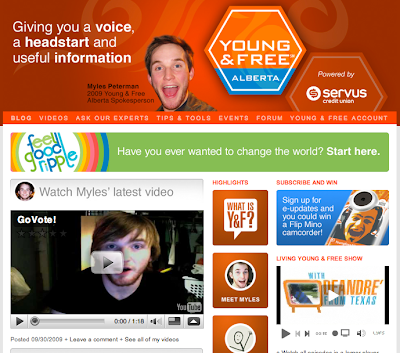Yes, I’m Canadian. And, no, I don’t know Bob from Vancouver. In fact, I didn’t even know about Servus from Alberta until I read about it in Springwise today.
You see, Servus is a Credit Union and not a bank. And for years, Credit Unions have been telling us Canadians why they’re so much better than their big, bad banking counterparts. The issues with this strategy? #1 Who believes b2c marketing messages anymore…even if they are from a Credit Union and #2 Who wants to be talked at? But alas, it seems that Servus has caught on to modern marketing – er, or should I say being meaningful.
Servus is handing out $10 bills to 20,000 of its customers. Simply asking them to continue the goodwill by passing it on to someone else…coining this process the Feel Good Ripple. They ask their customers to write about their experience at feelgoodripple.ca for a chance to win a $500 donation to their charity of choice. Since launching on September 26th, they’ve facilitated 384 ripples and hundreds (if not, thousands) of happy people…and counting. The beauty is that it reinforces what makes a credit union so unique. It CARES out its members, it’s DIFFERENT, it’s a part of the COMMUNITY. Hmmm, how about that? Communicating a message through an experience as opposed to marketing-speak.
This is actually the 2nd of such meaningful campaigns that I’m aware have been powered by Servus. Last year, after doing some research for a social media presentation I was giving, I found out about Young and Free Alberta, a free chequing account targeted to young people under 25 in Northern Alberta, Canada. Now if you know anything about marketing to Generation Y, you know that they’ve grown up with a mouse in their hand, bombarded with marketing-centric noise in a world overflowing with brands. The result is that they’re indifferent to the same tactics that captivated the older generations. So, how did Young and Free Alberta get over 2MM impressions, almost 2,000 new accounts and more than $2.6MM in Y&F account funds in just 6 months? They got in the hearts and minds of their target and built a community.
What they did:
– They actively sought out a community leader (aka spokesperson) that their members could relate to. In fact, they created a contest around hiring the voice of Y&F. They promoted the contest by asking applicants to create a video via YouTube and getting their friends to vote for them on the Y&F website. Get it? Facilitate something that young people create themselves. Then, let them do the work to promote it to all of their friends (who are also the target). And, create a voice for the organization that prospective members can relate to.
– They actively used social media channels to extend the conversation. Twitter, YouTube, Flickr, Facebook, FriendFeed, 12 Seconds and Blogs, oh my!
– They created a Y&F Show, providing the community with tips, tricks and hacks on how to get the most out of their money. In other words, they created content that that was helpful to their audience while reinforcing a message relevant to their offering (saving).
– They made it really easy to sign up for an account. Period.
– Aaaand, they kept track of results. Brilliant.
For more information:
Lara McCulloch-Carter
Author of the Special Event blog ready2spark
Director of Marketing – Regal Tent Productions
Past-President – ISES Toronto
. Follow me on Twitter
. Connect with me on LinkedIn
. Become my Peep at EventPeeps
. Befriend me at Events Network
